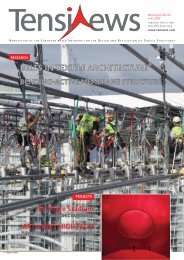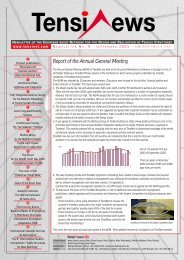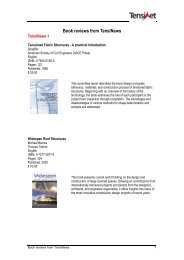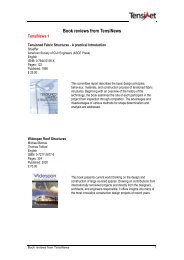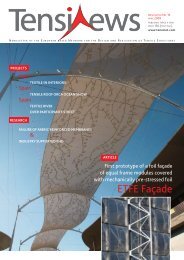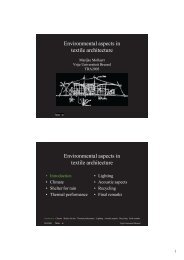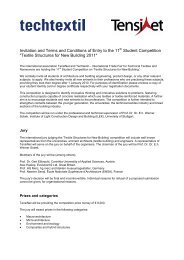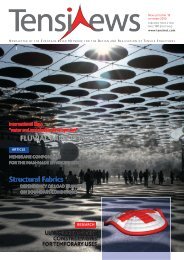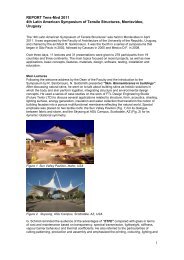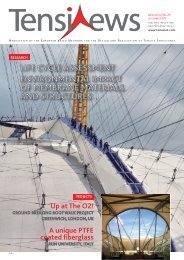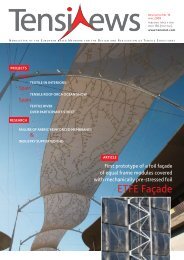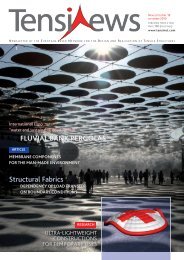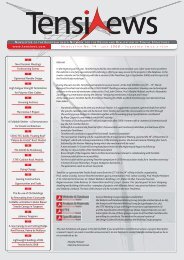Tensinews 21 - sept2011 - vers 31-8 - TensiNet
Tensinews 21 - sept2011 - vers 31-8 - TensiNet
Tensinews 21 - sept2011 - vers 31-8 - TensiNet
Create successful ePaper yourself
Turn your PDF publications into a flip-book with our unique Google optimized e-Paper software.
orthogo nal direction due to the Poisson's effect.<br />
As far as multidirectional stresses are concerned,<br />
the Von Mises formulas can be used to combine<br />
the stresses and strains into an equivalent stress<br />
and an equivalent strain. The corresponding<br />
curves are presented in the summary figure (C)<br />
for two uniaxial tests, two biaxial tests and one<br />
bursting test performed at room temperature at<br />
almost identical strain-rates. Results are very<br />
similar up to the second yield stress. Above the<br />
second yield stress the large deformations<br />
occurring in the material change its<br />
microstructure and therefore its mechanical<br />
properties. The material becomes anisotropic and<br />
its behaviour depends on the applied loading.<br />
Conclusion<br />
It has been shown that if an adequate post-processing<br />
is used then similar stress-strain curves<br />
are obtained up to the second yield stress with<br />
uniaxial and biaxial test procedures. Therefore<br />
uniaxial test can be used for measuring the material<br />
initial behaviour as they are very easy to perform<br />
and do not require much material and time.<br />
If the plastic behaviour or the failure of the material<br />
must be investigated then biaxial stresses<br />
must be applied. In that case the bursting test is<br />
the most suitable method as it allows very large<br />
biaxial deformations. This method is however limited<br />
to a single load ratio (1:1 for a circular sample).<br />
In order to apply different load ratios a<br />
biaxial test machine can be used.<br />
! Cédric Galliot<br />
: cedric.galliot@empa.ch<br />
! Rolf Luchsinger<br />
: rolf.luchsinger@empa.ch<br />
Center for Synergetic Structures<br />
: www.empa.ch/css<br />
REFERENCES<br />
[1] K. Moritz. Bauweisen der ETFE-Foliensysteme.<br />
Stahlbau 2007;76(5):336-342.<br />
[2] S. Robinson-Gayle, M. Kolokotroni, A. Cripps, S.<br />
Tanno. ETFE foil cushions in roofs and atria.<br />
Construction and Building Materials 2001;15:323-327.<br />
[3] Y. Xiang, J. Li. Calculation and design of ETFE<br />
membrane structures. In: Proceedings of the IASS<br />
Symposium, Beijing, 2006.<br />
[4] M. Wu, J. Lu. Experimental studies on ETFE cushion<br />
model. In: Proceedings of the IASS Symposium,<br />
Mexico, 2008.<br />
[5] K. Moritz. Time-Temperature-Shift (TTS) of ETFE-foils.<br />
In: Kröplin B, Oñate E, editors. International<br />
Conference on Textile Composites and Inflatable<br />
Structures, Structural Membranes 2009. CIMNE:<br />
Barcelona, 2009.<br />
[6] L. Schiemann, S. Hinz, M. Stephani. Tests of ETFE-foils<br />
under biaxial stresses. In: Kröplin B, Oñate E, editors.<br />
International Conference on Textile Com posites and<br />
Inflatable Structures, Structural Membranes 2009.<br />
CIMNE: Barcelona, 2009.<br />
[7] C. Galliot, R.H. Luchsinger. Uniaxial and biaxial<br />
mechanical properties of ETFE foils. Polymer Testing<br />
2011;30(4):356-365.<br />
8 TENSINEWS NR. <strong>21</strong> – SEPTEMBER 2011<br />
RESEARCH<br />
S(P)EEDKITS<br />
Rapid deployable kits as<br />
seeds for self-recovery<br />
The project ‘S(P)EEDKITS’ , which will start in 2012, will research rapid<br />
deployable kits as seeds for self-recovery in disaster affected sites. A multidisciplinary<br />
team, consisting of different organizations throughout Europe, will develop a new<br />
emergency system of modular rapid deployable shelters, facilities and medical care.<br />
The kits must be transportable, modular and adaptable, must have a low cost and<br />
must be high-tech in their conception but low-tech in use (Fig. 1 gives an example of a<br />
feasible kit. However the implementation of the kit, in the context of disaster relief<br />
shelters, still needs to be investigated). Current kits will be scanned with regard to<br />
large transportation volumes and/or heavy weight. Out of this knowledge, new<br />
concepts will be developed to drastically reduce the transportation volume and weight.<br />
The goal of these kits will be to provide temporary infrastructure, to establish the<br />
necessary temporary services and to limit the damage to economic and social fabrics.<br />
The kits should provide infrastructure for different purposes, e.g. a hospital,<br />
a communication centre, water facilities or sanitation units. Also four different basic<br />
shelter kits will be designed and analyzed:<br />
- A lightweight safe house unit: this shelter gives coverage for the very first<br />
hours and need to be deployed by the communities<br />
- A collective unit: a shelter which is usable for di<strong>vers</strong>e purposes<br />
- A family house unit: this shelter will be used in the transitional period and<br />
later, it can be referred to as the first <strong>vers</strong>ion of a real house<br />
- A robust warehouse unit: a somewhat larger shelter for the humani-ta rian<br />
organizations, it can be used for storage, offices, medical centers, etc.<br />
The need for these kits becomes evident when thinking about the many disasters,<br />
both nature- and man-made, that occur worldwide. As a result, countless people are<br />
rendered homeless without any medical care, sufficient and clean water, decent<br />
sanitation or energy supply. In case of such an emergency situation, humanitarian<br />
organizations (like the Red Cross, Red Crescent Movement and Médecins Sans<br />
Frontières) emergency response units to rebuild these affected sites. These units are<br />
sent out immediately after a disaster strikes. Each unit has his own field of expertise<br />
and consists of trained people and the necessary equipment (the ‘kit’) needed on site.<br />
The S(P)EEDKITS project wants to develop novel ‘kits’ that can be pre-positioned and<br />
mobilized more quickly and easily than existing ones.<br />
The S(P)EEDKITS project will be a collaboration between : Centexbel (BE),<br />
Shelter Research Unit (LU), Netherlands Red Cross (NL), Sioen Industries (BE),<br />
Vrije Uni<strong>vers</strong>iteit Brussel (BE), Technische Uni<strong>vers</strong>iteit Eindhoven (NL),<br />
Politecnico di Milano (IT), De Mobiele Fabriek (NL), Waste (NL), Practica (NL),<br />
D’Appolonia (IT), Internationales Biogas und Bioenergie Kompetenzzentrum (DE),<br />
Millson BV (NL), MSF Nederland (NL) and Norwegian Refugee Council (NO).<br />
! Jan Roekens - Vrije Uni<strong>vers</strong>iteit Brussel<br />
: jan.roekens@vub.ac.be<br />
! Guy Buyle - Centexbel<br />
: guy.buyle@centexbel.be<br />
Figure 1: First<br />
steps in the<br />
design of a<br />
possible disaster<br />
relief shelter kit




